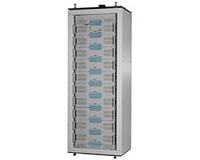 |
Washington DC (SPX) Dec 16, 2010 Moving a step closer toward quantum computing, a research team in the Netherlands recently fabricated a photodetector based on a single nanowire, in which the active element is a single quantum dot with a volume of a mere 7,000 cubic nanometers. The device is described in the American Institute of Physics' journal Applied Physics Letters. Photodetectors based on single quantum dots are expected to find uses in optoelectrical interfaces in future quantum computers, where single photons will carry information over long distances and single electrons will be used for computation. "Our research team fabricated a very localized light detector with dimensions far below the wavelength of light, which enables detection with very high spatial resolution," explains Val Zwiller of the Kavli Institute of Nanoscience at Delft University of Technology. "In addition, because quantum dots have discrete energy levels, only light in resonance with the energy levels of the quantum dot will be detected. "The indium phosphide (InP) nanowire was grown with standard epitaxial techniques and the quantum dot was obtained by sandwiching a thin segment in between with a lower bandgap. We created the device using electron beam lithography to contact a single nanowire."
Share This Article With Planet Earth
Related Links American Institute of Physics Nano Technology News From SpaceMart.com Computer Chip Architecture, Technology and Manufacture
 Charging Makes Nano-Sized Electrodes Swell, Elongate And Spiral
Charging Makes Nano-Sized Electrodes Swell, Elongate And SpiralRichland WA (SPX) Dec 14, 2010 New high resolution images of electrode wires made from materials used in rechargeable lithium ion batteries shows them contorting as they become charged with electricity. The thin, nano-sized wires writhe and fatten as lithium ions flow in during charging, according to a paper in this week's issue of the journal Science. The work suggests how rechargeable batteries eventually give out and ... read more |
|
| The content herein, unless otherwise known to be public domain, are Copyright 1995-2010 - SpaceDaily. AFP and UPI Wire Stories are copyright Agence France-Presse and United Press International. ESA Portal Reports are copyright European Space Agency. All NASA sourced material is public domain. Additional copyrights may apply in whole or part to other bona fide parties. Advertising does not imply endorsement,agreement or approval of any opinions, statements or information provided by SpaceDaily on any Web page published or hosted by SpaceDaily. Privacy Statement |